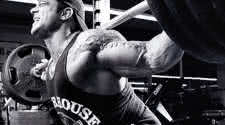Weight Training and Exercise using all Angles & Positions

Enhance your Training with Different Angles or POF
It's a known fact that you can make very effective and lasting gains training each major bodypart just once per week. To be successful
with this approach, you either have to up your set totals so you overtrain the bodypart enough that it needs seven full days to recover
or strategically place the direct and indirect work in your routine so the muscle doesn't atrophy. For example, you might do triceps,
including close-grip bench presses for pec stimulation, on one day and chest, with plenty of pressing for indirect triceps involvement,
three to four days later.
Whichever protocol you choose, you should still try to hit each muscle from the three positions, or angles, of flexion (POF) so that
you get full, complete development of each bodypart without wasted effort. For example, your quad routine should include two to three
sets of each of the following: squats, sissy squats and leg extensions. Without going into too much Positions-of-Flexion detail, here's
the reasoning behind this choice of exercises:
Squats = midrange work. This multi-joint movement trains your quads with synergy, or muscle teamwork. It involves the majority of the
target-muscle fibers precisely because that's how muscles are designed to work-in conjunction with other muscles. In other words, midrange
movements give you the most fiber-recruitment bang for your effort buck.
Sissy squats = stretch. This helps you hit the muscle in its total elongated, or stretch, position. When you twitch out of this stretch
at the bottom, you can help max out fiber recruitment.
Leg extensions = contraction. This movement allows you to squeeze the last bit of effort from the target muscle with resistance in its
ultimate contracted position.
Most trainees see the rationale behind the above exercise choices. Not only do you max out fiber recruitment, but you also train the muscle
through its complete range of motion-all the way from full stretch to complete contraction. Some trainees say POF "trains the entire length
of the muscle fibers," which is an interesting way to look at it. Unfortunately, those who train in a home gym don't have access to many
of the machines that provide complete contraction, such as a leg extension unit. What do you do then?
Here are a number of substitutes you can use if you're training with POF in a basic home gym.
Leg extensions (contracted position for quads). If you're using the above quad routine, go back to the squat rack after your sissy squats
and do two sets of full squats, but flex your quads for two seconds at the top of each rep.
Crossovers (stretch and contracted positions for lower pecs). Flex your pecs at the top of each rep of standard dumbbell flys. This way
you'll get somewhat of a peak contraction effect after each full stretch.
One-arm pushdowns (contracted position for triceps). Do kickbacks instead. This will give you resistance at the top, contracted position.
When you fail, do a couple of reps with stiff arms and some momentum to emphasize triceps contraction even more.
Leg curls (contracted position for hamstrings). Use partner-resistance leg curls. Your partner wraps a towel around your ankles and applies
pressure throughout the range of motion. These are actually more intense than standard machine leg curls because you can make every rep close
to a maximum effort.
Stiff-arm pulldowns (contracted position for lats). Do under grip bent-over rows, flexing your lats at the top of each rep.
These are just a few ideas on substituting exercises for effective multi-angle training.